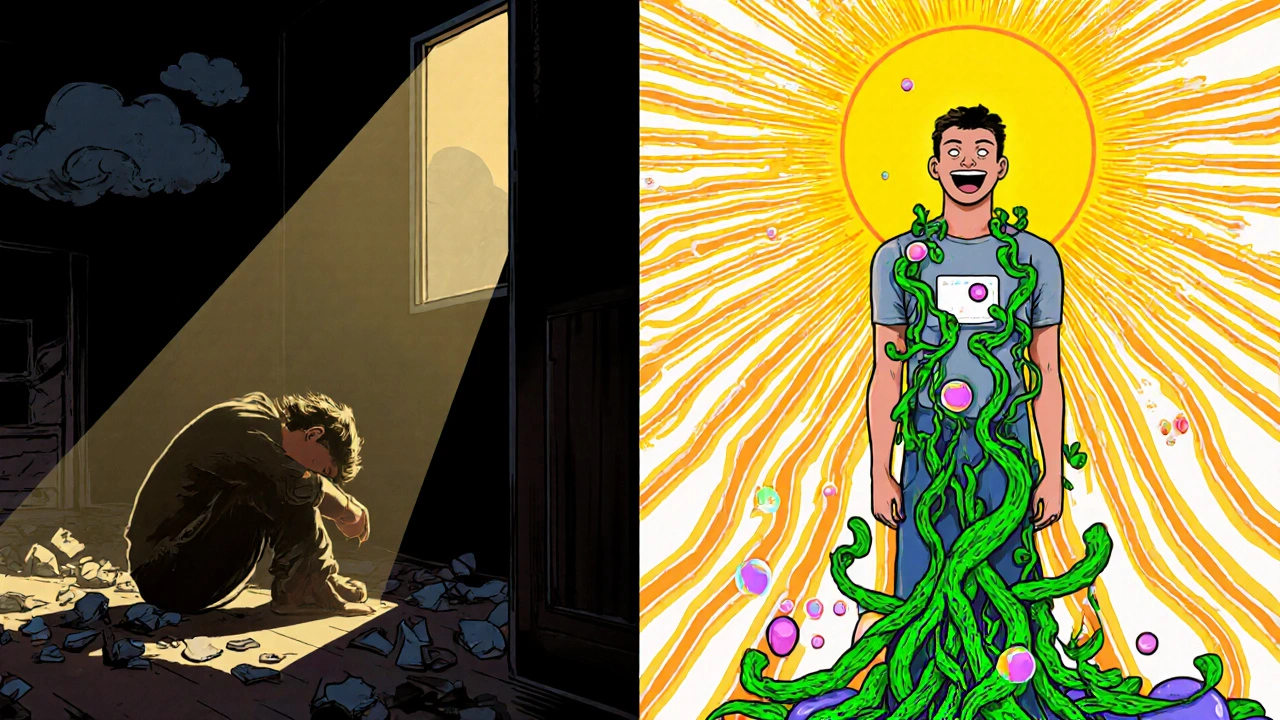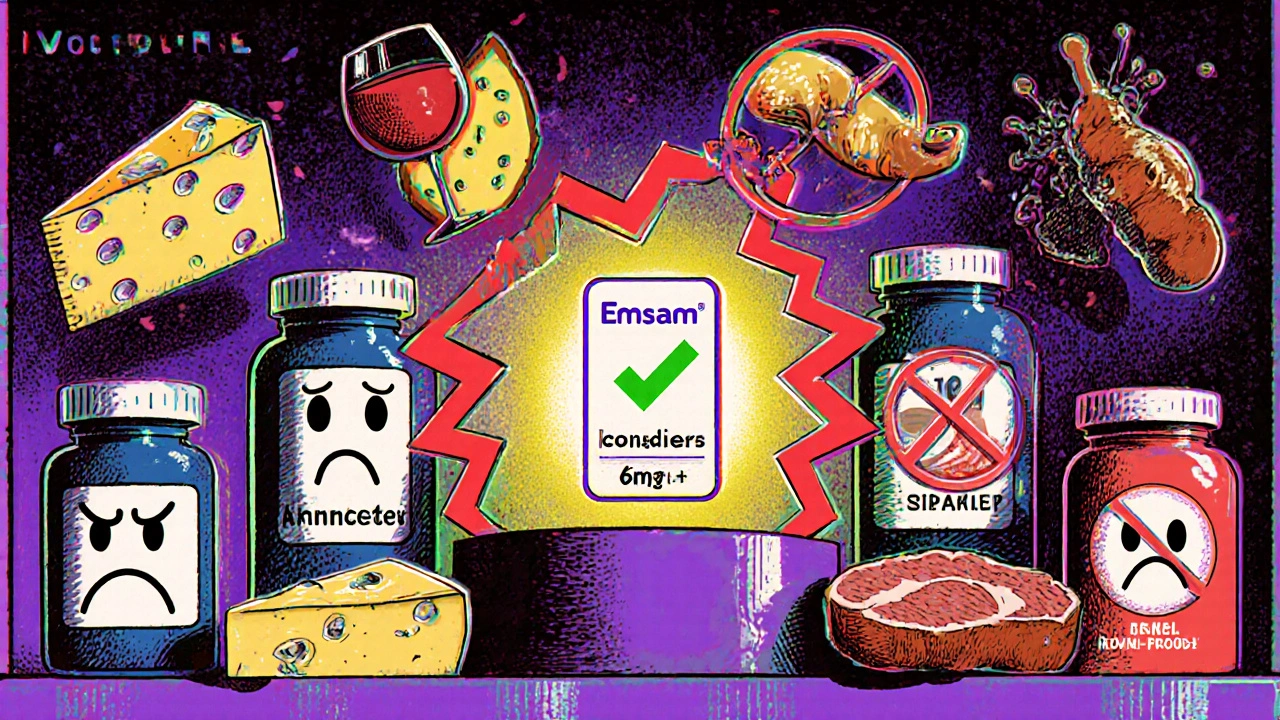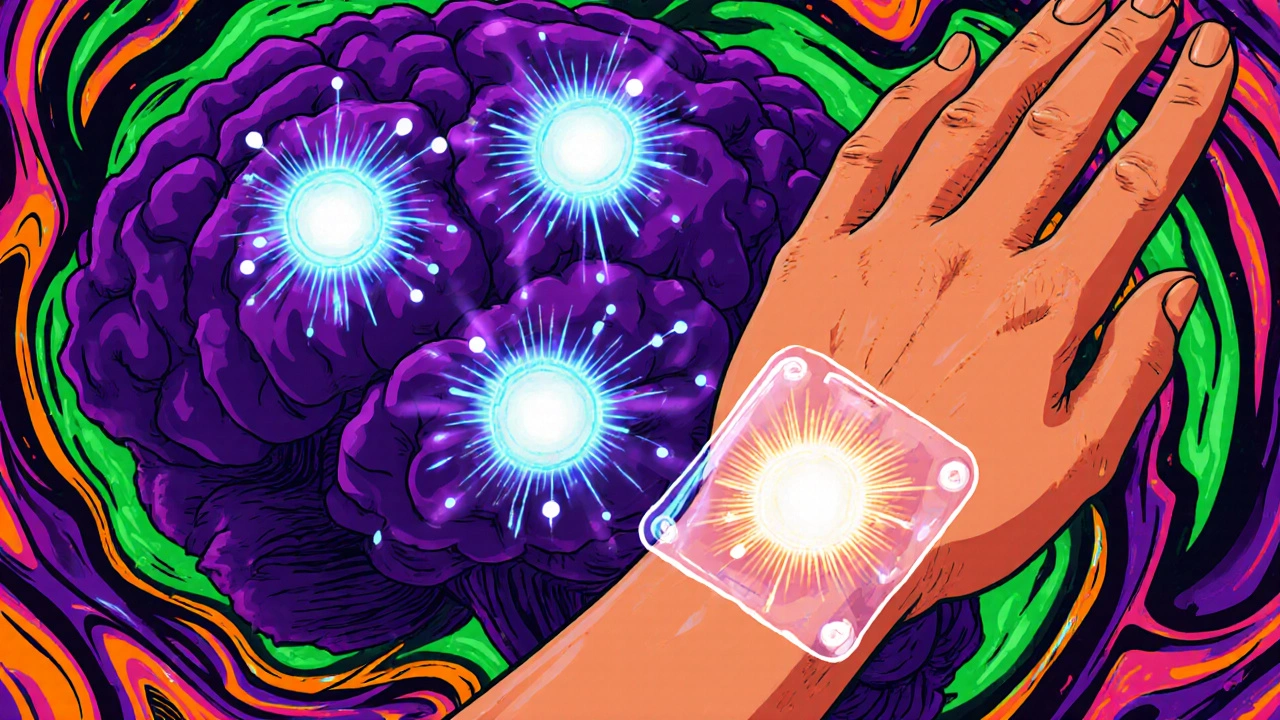Depression doesn’t always respond to the usual SSRIs or SNRIs. For some people, standard antidepressants just don’t cut it. That’s where selegiline comes in - a lesser-known but powerful option that’s been around since the 1960s. Unlike newer drugs, selegiline works differently. It doesn’t just boost serotonin or norepinephrine. It stops the enzymes that break them down in the first place. This makes it a unique tool, especially for treatment-resistant depression.
How selegiline actually works
Selegiline is a monoamine oxidase inhibitor, or MAOI. But not all MAOIs are the same. Older versions like phenelzine or tranylcypromine block both MAO-A and MAO-B enzymes. That’s why they come with strict dietary rules - they can cause dangerous spikes in blood pressure if you eat aged cheese, cured meats, or red wine.
Selegiline is different. At low doses (usually 6 mg per day or less), it selectively blocks only MAO-B. This enzyme mainly breaks down dopamine, which is why it was first used for Parkinson’s. But as the dose increases, it starts blocking MAO-A too - the enzyme that breaks down serotonin and norepinephrine. That’s when it starts acting like a traditional antidepressant.
There’s a reason this matters. By preserving dopamine, serotonin, and norepinephrine in the brain, selegiline helps restore the chemical balance that’s often disrupted in depression. Studies from the 1990s and early 2000s showed it worked as well as tricyclic antidepressants in patients who hadn’t responded to other treatments. More recent research, including a 2021 meta-analysis in the Journal of Affective Disorders, found selegiline had a response rate of about 55% in treatment-resistant cases - higher than placebo and comparable to other second-line options.
The patch form: why it’s a game-changer
Selegiline isn’t usually taken as a pill for depression. It’s delivered as a skin patch - the brand name is Emsam. This form is important because it bypasses the gut. When you swallow selegiline, your liver breaks down a lot of it before it even reaches your brain. That’s why oral doses need to be higher and come with more side effects.
The patch delivers selegiline directly into your bloodstream. That means lower doses can be just as effective. The FDA approved Emsam in 2006 for major depression. It comes in three strengths: 6 mg/24 hours, 9 mg/24 hours, and 12 mg/24 hours. At the lowest dose (6 mg), you don’t need to change your diet. That’s huge. No more avoiding salami or soy sauce. At higher doses, dietary restrictions kick in, but many patients never need to go beyond 6 mg.
A 2018 clinical trial followed 212 adults with moderate to severe depression. Half got the 6 mg patch, half got a placebo. After six weeks, 47% of the selegiline group saw at least a 50% drop in symptoms, compared to 27% in the placebo group. That’s not just statistically significant - it’s meaningful for someone who’s been stuck in depression for years.
Who benefits most from selegiline?
Selegiline isn’t for everyone. But it shines in specific cases:
- Atypical depression - where you feel heavy, sleep too much, eat too much, and are hypersensitive to rejection. Selegiline is one of the few antidepressants that consistently helps this subtype.
- Treatment-resistant depression - when two or more SSRIs or SNRIs have failed. Selegiline is often the next step in clinical guidelines.
- Depression with fatigue or low energy - because it boosts dopamine, it can help with motivation and drive, not just mood.
- People who can’t tolerate weight gain or sexual side effects - unlike SSRIs, selegiline rarely causes these issues.
It’s also used off-label for depression in older adults. Because it doesn’t cause drowsiness or confusion like some older antidepressants, it’s often better tolerated in patients over 65. A 2020 study in International Journal of Geriatric Psychiatry found selegiline patches improved both mood and daily functioning in elderly patients with depression, with fewer cognitive side effects than sertraline.

Side effects you should know about
Selegiline is generally well-tolerated, but it’s not without risks. The most common side effects are mild: dry mouth, dizziness, nausea, or skin irritation where the patch is applied. These usually fade after the first two weeks.
The big concern is serotonin syndrome - a rare but dangerous condition caused by too much serotonin. It’s unlikely with the patch at 6 mg, but the risk increases if you combine selegiline with other serotonergic drugs like tramadol, certain migraine meds (triptans), or even St. John’s wort. Always tell your doctor about everything you’re taking.
At higher doses (9 mg or 12 mg), dietary restrictions apply. You must avoid foods high in tyramine: aged cheeses, fermented soy, tap beer, cured meats, and overripe bananas. A single bite of blue cheese could trigger a sudden, dangerous rise in blood pressure. That’s why the 6 mg patch is often the best starting point - it avoids this entirely.
Another rare risk is orthostatic hypotension - feeling lightheaded when standing up. This is more common in older adults or those on blood pressure meds. It’s usually manageable by standing up slowly and staying hydrated.
How long does it take to work?
Unlike SSRIs, which can take 4-6 weeks to show results, selegiline often starts working faster. Many people notice a lift in energy or mood within 10-14 days. Full benefits usually appear by week 4-6. This quicker onset is one reason clinicians turn to it when someone is severely depressed and needs relief fast.
It’s also easier to stop than some other antidepressants. You don’t need to taper slowly unless you’ve been on a high dose for a long time. The patch can be removed, and you’re done. No withdrawal symptoms like brain zaps or dizziness - unless you’ve been on it for over a year, which is rare.
How it compares to other antidepressants
| Feature | Selegiline Patch (Emsam) | SSRIs (e.g., sertraline) | SNRIs (e.g., venlafaxine) | Tricyclics (e.g., amitriptyline) |
|---|---|---|---|---|
| Onset of action | 1-2 weeks | 4-6 weeks | 3-5 weeks | 2-4 weeks |
| Dietary restrictions | Only at doses >6 mg | None | None | None |
| Sexual side effects | Low risk | High risk | High risk | High risk |
| Weight gain | Uncommon | Common | Moderate | Very common |
| Energy/fatigue | Improves | Neutral or worsens | Neutral | Often causes drowsiness |
| Best for atypical depression | Yes | No | No | Moderate |
Selegiline doesn’t replace SSRIs. But for people who’ve tried them and still feel stuck - especially if they’re tired, unmotivated, or have atypical symptoms - it’s one of the most effective next steps.

Real-world use: what patients say
In clinical practice, selegiline patches are often prescribed after two failed antidepressant trials. A 2023 survey of 187 psychiatrists in the U.S. found that 68% had prescribed Emsam for depression in the past year. Most used the 6 mg patch as a first-line MAOI option because of its safety profile.
One patient, a 52-year-old teacher from Portland, described her experience: “I’d been on four different SSRIs. Nothing worked. I was exhausted, cried every day, and couldn’t get out of bed. My doctor suggested the patch. I didn’t believe it would help. But after three weeks, I started laughing again. Not because something good happened - just because I felt like myself.”
That’s the power of selegiline. It doesn’t just lift mood. It restores the ability to feel - even when nothing seems to be going right.
Is selegiline right for you?
Selegiline isn’t a first-choice drug. But it shouldn’t be a last resort either. If you’ve tried multiple antidepressants and still struggle with low energy, oversleeping, or emotional numbness, it’s worth discussing.
Ask your doctor:
- Have I tried enough other treatments?
- Do I have atypical depression symptoms?
- Can I safely avoid tyramine-rich foods if needed?
- Am I on any other medications that could interact?
Selegiline isn’t magic. But for the right person, it can be the missing piece.
Is selegiline better than SSRIs for depression?
Selegiline isn’t better for everyone, but it’s often more effective for people with treatment-resistant or atypical depression. Unlike SSRIs, it boosts dopamine as well as serotonin and norepinephrine, which helps with energy and motivation. It also causes fewer sexual side effects and less weight gain. However, SSRIs are safer for most people and don’t require dietary changes at low doses. Selegiline is typically used after SSRIs have failed.
Can I drink alcohol while taking selegiline?
It’s best to avoid alcohol, especially at higher doses of selegiline. Even at the lowest patch dose (6 mg), alcohol can increase dizziness or lower blood pressure. At doses above 6 mg, alcohol combined with tyramine-containing foods can trigger dangerous blood pressure spikes. To be safe, limit or avoid alcohol entirely while on selegiline.
How long should I stay on selegiline?
Most people take selegiline for at least 6-12 months after symptoms improve. If you’ve had multiple depressive episodes, your doctor may recommend continuing longer. Stopping too soon increases the risk of relapse. Unlike some antidepressants, you don’t need to taper slowly unless you’ve been on a high dose for over a year.
Does selegiline cause weight gain?
No, selegiline is unlikely to cause weight gain. In fact, some patients report weight loss due to improved energy and reduced emotional eating. This is one reason it’s preferred over SSRIs and tricyclics, which commonly lead to weight gain. Studies show less than 5% of users gain more than 5 pounds on selegiline.
Can selegiline help with anxiety too?
Yes, selegiline can help with anxiety, especially when it’s tied to depression. It’s particularly effective for social anxiety and panic symptoms in people with atypical depression. Unlike benzodiazepines, it doesn’t cause dependence. While it’s not FDA-approved for anxiety alone, many clinicians use it off-label when anxiety and depression occur together.
What to do next
If you’ve tried other antidepressants and still feel stuck, talk to your doctor about selegiline. Bring up your symptoms - especially if you’re tired, oversleeping, or have intense emotional reactions. Ask if the 6 mg patch might be an option. Don’t assume it’s too old or too risky. It’s a proven tool, and for the right person, it can change everything.

Lorne Wellington
October 30, 2025 AT 18:42Man, I wish I'd known about this patch years ago. I was on like five SSRIs and felt like a zombie with a side of emotional numbness. The 6mg patch? Game changer. No more avoiding cheese, no more sexual side effects, and suddenly I could get out of bed without crying. Still take it every morning like clockwork. Life’s not perfect, but it’s livable again. 🙌
Will RD
November 1, 2025 AT 01:12MAOIs are dangerous af dont be stupid. people die from cheese and wine with these. why are you promoting this like its a miracle drug? its a last resort for a reason.
Jacqueline Anwar
November 2, 2025 AT 08:45While I appreciate the thoroughness of this exposition, I must express my profound concern regarding the casual endorsement of monoamine oxidase inhibitors in a public forum. The pharmacological risks, particularly in polypharmacy scenarios, are not trivial. One must exercise extreme caution, and I would argue that such interventions ought to be reserved exclusively for specialists under rigorous monitoring.
Ganesh Kamble
November 4, 2025 AT 03:47lol why even bother with this patch? just take weed or psilocybin. way safer and you actually feel alive. this is 1990s medicine trying to look cool.
Jenni Waugh
November 4, 2025 AT 13:11Oh, so now we’re glorifying MAOIs like they’re some kind of elite antidepressant club? Let me guess - you’re one of those people who thinks ‘natural’ means ‘better’ and ignores the fact that this drug can kill you if you eat a single slice of blue cheese? Please. We have SSRIs for a reason. Your ‘energy boost’ is just a chemical gamble with your blood pressure.
Theresa Ordonda
November 4, 2025 AT 18:18Okay but… the patch? I’ve been on the 6mg for 8 months. No dietary drama. No weight gain. No brain zaps when I stop. And honestly? I laugh more. Like, actual laughter. Not the fake ‘I’m fine’ kind. I’m not even mad that it’s expensive - it’s worth every penny. 🌈💊
Judy Schumacher
November 5, 2025 AT 05:08It is imperative to note, with the utmost seriousness, that the normalization of MAOI usage in online discourse is both irresponsible and profoundly ill-advised. The pharmacokinetic profile of selegiline, particularly its irreversible binding to monoamine oxidase enzymes, renders it uniquely hazardous in the context of modern polypharmacy. One must consider the potential for catastrophic serotonin syndrome, especially in light of the widespread, unregulated use of supplements such as St. John’s Wort, which are often co-administered without medical supervision. This is not a ‘next step’ - it is a clinical minefield.
Megan Raines
November 5, 2025 AT 15:13So… you’re telling me the patch doesn’t make me avoid cheese? And I don’t have to be terrified every time I order a salad? Huh. I guess I’ll try it. Not because I trust the science - but because I’m tired of feeling like a ghost in my own life.
Mamadou Seck
November 6, 2025 AT 23:21Why even use this when you can just do therapy and exercise? This is just more pharma brainwashing. They make you think you need a pill for everything. I’ve been off meds for 3 years and I’m fine
Anthony Griek
November 7, 2025 AT 10:14My cousin tried this after years of SSRIs failing. She said the patch was the first thing that didn’t make her feel like she was drugged up. She still gets a little dizzy sometimes but says it’s worth it. I’m not a doctor but I’ve seen it work. Just don’t skip the talk with your prescriber.
Norman Rexford
November 8, 2025 AT 16:53Look I get it America’s got a pill problem but this is just the same old stuff dressed up. We need real solutions like community, purpose, real food not this chemical crutch. Also why is everyone so obsessed with dopamine? We ain’t rats in a lab
Wayne Keller
November 9, 2025 AT 18:47If you’ve tried SSRIs and nothing worked - this might be your answer. Not because it’s magic, but because it works differently. The patch is low-key brilliant. No diet jail at 6mg. No weight gain. No sex problems. And it kicks in faster. Talk to your doctor. Don’t just scroll and assume it’s too risky.
Shana Labed
November 10, 2025 AT 11:18OMG I’M SO GLAD THIS EXISTED. I had atypical depression - slept 12 hours, cried while eating cereal, felt like my soul was buried under concrete. The patch? After 10 days I made myself a smoothie and actually SMILED. Not because something good happened - just because I felt like ME again. This isn’t just treatment - it’s a resurrection. 🙏✨
California Daughter
November 12, 2025 AT 02:04…Wait, so you can eat cheese? Just… cheese? No other restrictions? That’s it? I mean… I guess that’s… kind of amazing? But also… why didn’t anyone tell me this before? I’ve been avoiding cheddar for no reason? 😭
Vishwajeet Gade
November 13, 2025 AT 08:20Selegiline? In India we just take ashwagandha and chill. This is western overmedication. You don’t need a patch to fix your mind. Just stop being soft. Go to temple. Walk barefoot. Eat turmeric. Problem solved.